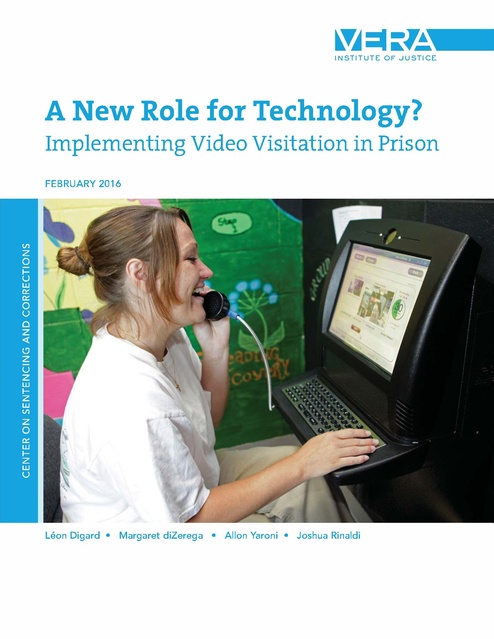A New Role for Technology - Implementing Video Visitation in Prison, Vera, 2016
Download original document:

Document text

Document text
This text is machine-read, and may contain errors. Check the original document to verify accuracy.
INSTITUTE OF .JUSTICE A New Role for Technology? Implementing Video Visitation in Prison FEBRUARY 2016 Leon Digard • Margaret diZerega • Allon Yaroni • Joshua Rinaldi Bureau chiefs, program coordinators, staff from DOC budget departments, and research and planning officers completed the survey. The survey tool for incarcerated people also collected contact information for respondents’ loved ones in the community. Vera researchers will contact a sample of this group for phone interviews regarding their experiences of video visitation and report the results at a later date. At the time of survey, women accounted for 7.6 percent of the population in WADOC’s custody. Sampling at this same rate would have included too few female participants for their experiences to be represented meaningfully. The researchers therefore intentionally oversampled incarcerated women, who comprised 26 percent of the sample. The survey sample slightly under-represents incarcerated Hispanic and Latino people at 9.8 percent, compared to the state DOC's reported figure of 12.7 percent. However, the sample was broadly representative of the WADOC incarcerated population for the same year in terms of race and age. All demographic information is taken from the Washington State Department of Corrections Fact Card, December 31, 2014. Figure 1: Prevalence of video visitation by state DOCs Unreported No intention Undecided Intend to implement Securing/Implementing Low availability Medium availability High availability * Alaska uses video visitation only for state prisoners held by the Colorado Department of Corrections. Tennessee uses video visitation only for visits with people held in maximum security housing units. Incarcerated people con r ed t at distance was a substantial barrier to face-to-face contact. or so e ideo isitation is t e onl wa t e can see t eir fa il . e i ple entation of ideo isitation ad irtuall no i pact on t e states budget because WADOC used a fullser ice pro ider. Note: Alaska and Ohio did not provide information on the fees. Video Visiting in Corrections: Benefits, Limitations, and Implementation Considerations In its internal re iew WADOC found inappropriate be a ior in fewer t an percent of t e ideo isits. VIDEO VISIT RATE PER 1000 PRISO N ERS 35 30 25 20 15 10 5 0 FEB 2013 APR JUN AUG OCT DEC FEB APR JUN 2014 AUG OCT DEC 2014 DOCs need to consider w et er adding co issions onto t e price of a ideo isit will reinforce or under ine t eir goal of keeping fa ilies connected. Criminal Justice and Behavior The Prison Journal Criminal Justice Policy Review The Journal of Research in Crime and Delinquency The American Psychologist Journal of Contemporary Criminal Justice Video Visiting in Corrections: Benefits, Limitations, and Implementation Considerations Screening Out Family Time: The for-profit video visitation industry in prisons and jails Star Tribune American Community Survey Reports Mobile Technology Fact Sheet Census of State and Federal Correctional Facilities ABOUT CITATIONS: A New Role for Technology? Implement ing Video Visitat ion in Prison.





